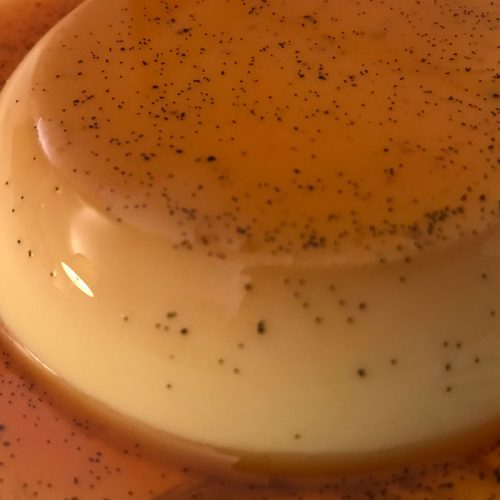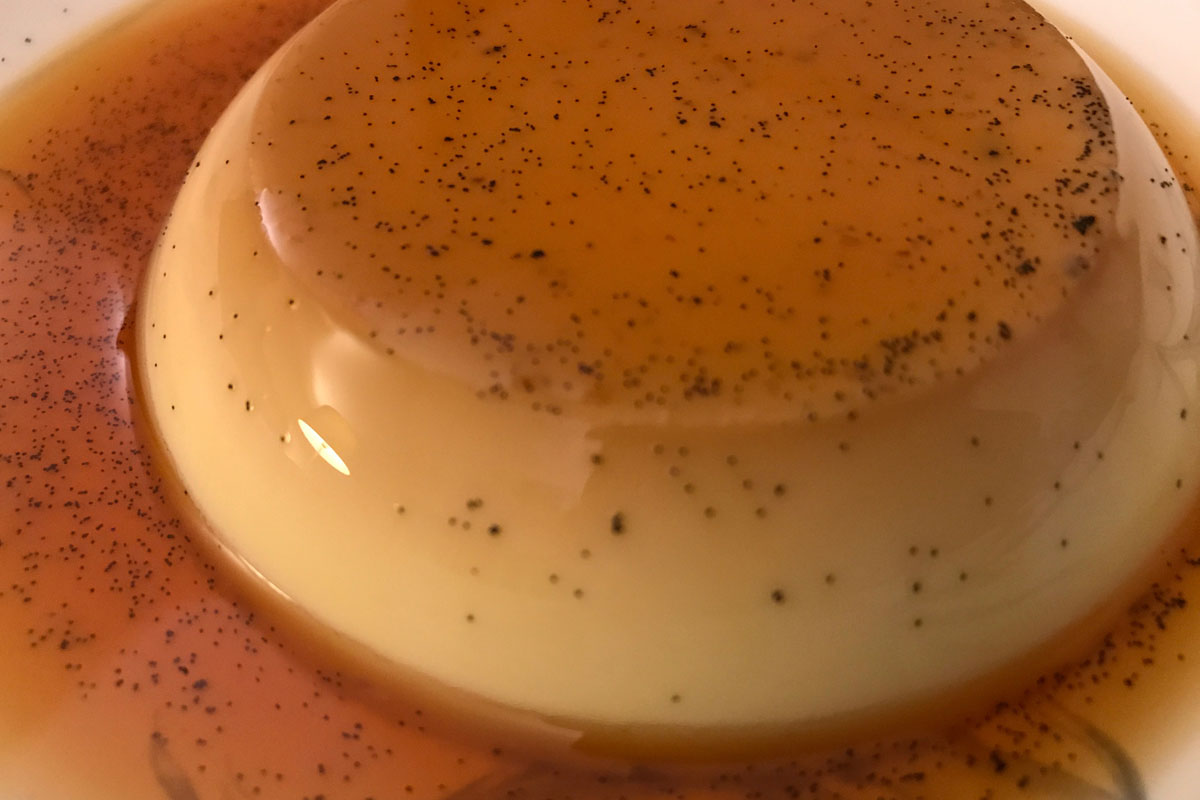Crème caramel or flan has its origin in Portugal, Spain and France. Due to the vast exploration and colonization trips this dessert is also enjoyed today in many countries: Japan, Vietnam, Philippines, Brazil, Mexico to name a few. In its most basic form one needs milk, eggs and sugar. We use also some gelatin to avoid the au bain-marie baking step in the oven. In order to get the right blend of flavours, make this desert one or two days in advance.
The art of making crème caramel or flan
The most important part is to prevent burning the sugar for the caramel layer. Actual diluting the caramel syrup with a small amount of hot water, may help to make the caramel thinner and improve mixing the caramel with the milk-egg at the interface for improved taste. The next attention point is to not ‘overcook’ the milk/egg/sugar mixture. And if you can use vanilla caviar from a bean, it provides so much more taste.
Store the deserts in separate bowls or ramekins in the refrigerator to let the milk-egg layer settle and the taste develop.
Special equipment
- Au bain marie pans
- 8 ramekins or small bowls
- fine mesh strainer

Crème caramel or flan
Ingredients
Ingredients to make the caramel sauce
- 2/3 cup (140 g) sugar
- 2 tbsp (30 g) very hot water+ 1.5 liter for heating the ramekins
- 2 tbsp (30g) cold water
Ingredients to make the custard
- 4 sheets (10 g) gelatine
- 1/4 cup (60 g) water
- 5 medium egg yolks (or 4 large ones)
- 1/3 cup + 1 tbsp (80 g) sugar
- 1 3/4 cups (400 ml) full cream milk
- 1/2 cup (120 ml) heavy whipping cream
- 1 vanilla bean
Instructions
Instruction to make the caramel sauce
- Warning: Please wear an apron, oven mitts, glasses and have no bare body parts exposed as splashing may occur. Also when sugar is dry heated too much and too far, self-decomposition may occur resulting in the production of soot and bad smell. The fumes are actually combustible, so be careful when doing this on an open flame. Never do this unattended.
- Prepare the ramekins or small bowls and poor hot water into them. Let stand.
- Heat up some water till boiling and prepare a wet, very damp kitchen towel. Lay this kitchen towel folded next to your stove
- Add the sugar and cold water to a sauce pan over medium heat. The cold water helps to prevent hot spots occurring in your pan and distributes the sugar evenly.
- Do not stir the mixture, but only shake the pan gently until the mixture starts to color and turn golden brown. Continue to swirl the pan to ensure a homogeneous color develops until the color is a deep amber. This step may take 6-8 minutes
- When the amber color is reached, immediately remove from the heat source and place on a cold, wet towel and add 2 tbsp of the very hot water. Please wear protective gear to protect from splashes
- Empty the warm water from the ramekins or bowls and just quickly drain. Do not dry them
- Then while the sauce pan with the caramel is still hot, evenly distribute the caramel among the ramekins or bowls and let thicken on the kitchen counter. Meanwhile start working on the custard
Instruction to make the custard
- Cut with a sharp knife the vanilla bean open over the length and with the back of the knife remove the black vanilla caviar. Reserve
- Pour around 1/4 cup cold water in a deep plate and immerse the gelatine sheets one by one in the water and let stand for 5 minutes
- In a large mixing bowl mix the egg yolks and the sugar with a whisk until creamy and pale yellow
- Use the microwave or a saucepan to heat almost 1 cup of milk until the milk is warm to the touch. The rest of the milk we will use later
- Slowly add the milk to the egg yolk-sugar mixture, whisking constantly
- Pour the entire mixture in a sauce pan and heat au bain marie the mixture, stirring constantly. Also here do not leave the pan unattended and keep stirring to prevent that the mixture burns on the bottom or sides. The mixture will become thicker and small bubbles may form on the edges. And if you like to measure, the temperature should be 160 F (71 C)
- At that time, add the bloomed gelatin-water mixture and remove from the heat.
- Add the remaining cold milk, the cold cream and the vanilla caviar and whisk together. This will help to cool down the mixture
- Divide the custard evenly over the ramekins or bowl and thus poor on top of the thickened caramel sauce
- Cover with plastic wrap and refrigerate for up to 3 days. The caramel layer will become thinner, due to the moisture from the custard layer
- Before serving, run a small knife or toothpick around the edge of each bowl to loosen the custard. Then quickly invert each bowl on a plate.
Notes
Remarks
- Do not make the caramel layer too thick, as otherwise most of the caramel will remain in the form when serving Therefore adding the hot water to the caramelized sugar is essential
- The dessert needs at least an overnight in the fridge and can be stored for a maximum 3 days. Each day the caramel sauce will become thinner, but less caramel sauce will stay behind in the bowls.



